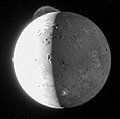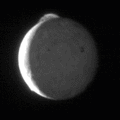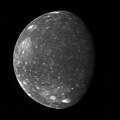Vaizdas:NewHorizonsIo.jpg
NewHorizonsIo.jpg (330 × 326 taškų, rinkmenos dydis: 24 KiB, MIME tipas: image/jpeg)
Rinkmenos istorija
Paspauskite ant datos/laiko, kad pamatytumėte rinkmeną tokią, kokia ji buvo tuo metu.
| Data/Laikas | Miniatiūra | Matmenys | Naudotojas | Paaiškinimas | |
|---|---|---|---|---|---|
| dabartinis | 02:36, 23 gruodžio 2022 |  | 330 × 326 (24 KiB) | Ras67 | == {{int:filedesc}} == {{Information |Description={{en|1=Image of Io taken by New Horizons on February 28, 2007. * This dramatic image of Io was taken by the Long Range Reconnaissance Imager (LORRI) on New Horizons at 11:04 Universal Time on February 28, 2007, just about 5 hours after the spacecraft's closest approach to Jupiter. The distance to Io was 2.5 million kilometers (1.5 million miles) and the image is centered at 85 degrees west longitude. At this distance, one LORRI pixel subtends... |
Paveikslėlio naudojimas
Paveikslėlis yra naudojamas šiuose puslapiuose:
Visuotinis rinkmenos naudojimas
Ši rinkmena naudojama šiose viki svetainėse:
- Naudojama af.wikipedia.org
- Naudojama en.wikipedia.org
- Naudojama hr.wikipedia.org
- Naudojama it.wikipedia.org
- Naudojama ko.wikipedia.org
- Naudojama no.wikipedia.org
- Naudojama pt.wikipedia.org
- Naudojama sh.wikipedia.org
- Naudojama th.wikipedia.org
- Naudojama vi.wikipedia.org
- Naudojama zh.wikipedia.org












